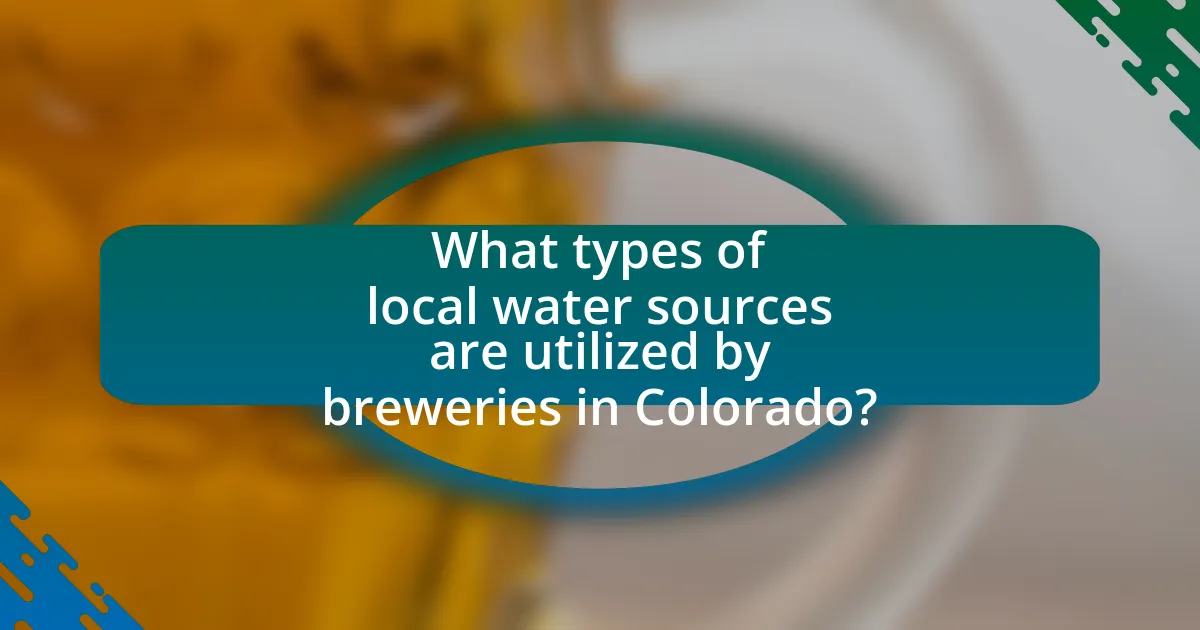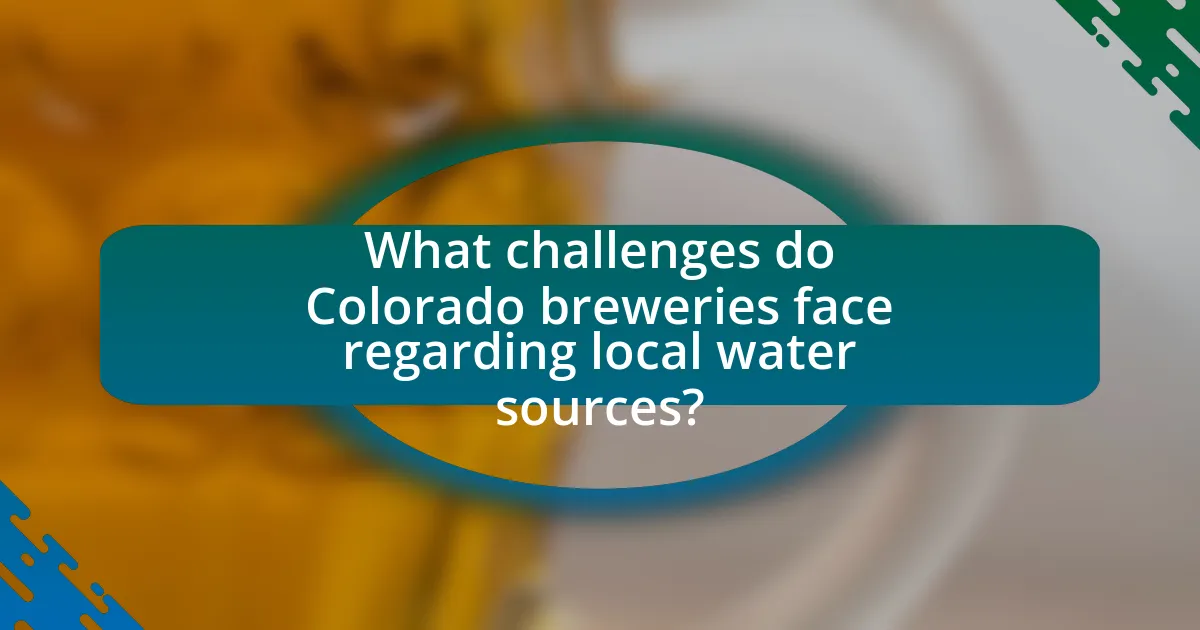The article examines the critical role of local water sources in Colorado’s brewing industry, highlighting how the unique mineral content and purity of water from the Rocky Mountains influence beer quality and flavor profiles. It discusses the specific characteristics of water, such as mineral content, pH levels, and hardness, and their impact on the brewing process and beer styles. Additionally, the article addresses the challenges breweries face regarding water scarcity and regulations, as well as the sustainable practices they can adopt to ensure responsible water use. Overall, it emphasizes the importance of local water sources in creating distinctive regional beers and fostering community connections.
What is the significance of local water sources in Colorado’s brewing industry?
Local water sources are crucial to Colorado’s brewing industry because they directly influence the quality and flavor profile of the beer produced. The unique mineral content and purity of Colorado’s water, sourced from the Rocky Mountains, contribute to the distinct characteristics of various beer styles. For instance, the water from the Clear Creek watershed is known for its soft profile, ideal for brewing lagers, while the harder water from the South Platte River is preferred for brewing pale ales and IPAs. This regional specificity not only enhances the taste but also allows brewers to create signature beers that reflect the local terroir, thereby fostering a strong connection between the community and its brewing heritage.
How do local water sources influence the brewing process?
Local water sources significantly influence the brewing process by affecting the mineral content and pH levels, which in turn impact the flavor and quality of the beer. For instance, water with high mineral content can enhance the mouthfeel and overall taste profile of the beer, while water with a balanced pH is essential for optimal enzyme activity during mashing. In Colorado, many breweries utilize local water sources, such as rivers and aquifers, which are known for their unique mineral compositions. This local specificity allows brewers to tailor their recipes to highlight the characteristics imparted by the water, leading to distinct regional flavors. Studies have shown that variations in water chemistry can lead to differences in beer styles, with certain minerals promoting specific flavor notes, thus validating the critical role of local water sources in the brewing process.
What specific water characteristics are important for brewing?
The specific water characteristics important for brewing include mineral content, pH level, and hardness. Mineral content, particularly calcium, magnesium, and sulfate, influences flavor and clarity; for example, calcium enhances yeast activity and stability. The pH level, ideally between 5.2 and 5.6, affects enzyme activity during mashing, impacting sugar extraction. Hardness, defined by the concentration of calcium and magnesium ions, can affect the mouthfeel and overall taste of the beer. Studies show that different beer styles benefit from varying mineral profiles, underscoring the importance of local water sources in brewing processes.
How do different water profiles affect beer flavor and quality?
Different water profiles significantly affect beer flavor and quality by influencing the mineral content, pH, and overall chemistry of the brewing process. For instance, water high in calcium enhances malt sweetness and promotes yeast health, while sulfate-rich water accentuates hop bitterness, creating a drier finish. Conversely, water with high bicarbonate levels can lead to a more rounded, malt-forward flavor profile. Research indicates that specific water profiles, such as those found in Colorado, can enhance the distinctiveness of local beer styles, as brewers often tailor their recipes to leverage the unique mineral compositions of their water sources. This adaptability is crucial for achieving desired flavor characteristics and maintaining quality in the final product.
Why are local water sources preferred over other options?
Local water sources are preferred over other options because they provide unique mineral compositions that enhance the flavor profile of beer. In Colorado’s brewing industry, the specific characteristics of local water, such as its pH and mineral content, contribute to the distinct taste and quality of the final product. For instance, the water from the Rocky Mountains is known for its purity and balanced mineral content, which is ideal for brewing various beer styles. This reliance on local water not only supports the authenticity of the beer but also promotes sustainability by reducing transportation costs and environmental impact associated with sourcing water from distant locations.
What advantages do local water sources provide to brewers?
Local water sources provide brewers with distinct advantages, including unique mineral compositions that enhance flavor profiles. The specific mineral content in local water can influence the taste, mouthfeel, and overall quality of the beer, allowing brewers to create distinctive regional styles. For instance, Colorado’s water is known for its purity and balanced mineral content, which is ideal for brewing various beer types, from pale ales to stouts. This local sourcing also reduces transportation costs and environmental impact, making it a sustainable choice for breweries. Additionally, using local water fosters a connection to the community and local agriculture, further enriching the brewing culture.
How does using local water contribute to sustainability in brewing?
Using local water contributes to sustainability in brewing by reducing transportation emissions and ensuring the use of regionally adapted water profiles that enhance beer quality. Local water sources minimize the carbon footprint associated with transporting water over long distances, which is crucial in an industry that values environmental responsibility. Additionally, Colorado’s unique water chemistry, influenced by its geology, allows brewers to create distinctive flavors that reflect the local terroir, promoting both quality and sustainability. This practice supports local ecosystems and economies, aligning with sustainable brewing principles.

What types of local water sources are utilized by breweries in Colorado?
Breweries in Colorado utilize various local water sources, primarily including mountain spring water, river water, and groundwater. Mountain spring water is favored for its purity and mineral content, which can enhance the flavor profile of the beer. River water, sourced from the numerous rivers in the state, is also commonly used, providing a diverse range of mineral compositions depending on the river’s location. Groundwater, accessed through wells, is another significant source, often treated to meet brewing standards. These water sources are essential for the brewing process, as they contribute to the overall quality and taste of the final product.
What are the main sources of water for breweries in Colorado?
The main sources of water for breweries in Colorado are municipal water supplies, groundwater, and surface water from rivers and reservoirs. Municipal water systems provide a significant portion of the water used in brewing, with many breweries relying on treated water from local municipalities. Groundwater is accessed through wells, offering a reliable source, particularly in areas where surface water is less available. Additionally, surface water from rivers and reservoirs, such as the South Platte River and the Colorado River, is utilized, especially for breweries located near these water bodies. These sources are essential for maintaining the quality and consistency of the beer produced in Colorado’s brewing industry.
How do rivers and lakes serve as water sources for brewing?
Rivers and lakes serve as essential water sources for brewing by providing high-quality water that is crucial for the brewing process. The mineral content and pH levels of water from these natural sources can significantly influence the flavor and characteristics of the beer produced. For instance, Colorado’s rivers, such as the South Platte and the Arkansas, are known for their clean, mineral-rich waters, which are ideal for brewing various beer styles. Studies have shown that the specific mineral composition, including calcium and magnesium levels, can enhance the brewing process and the final product’s taste. This reliance on local water sources not only supports the brewing industry but also emphasizes the importance of water quality in beer production.
What role do groundwater and aquifers play in the brewing industry?
Groundwater and aquifers are essential for the brewing industry as they provide a primary source of water, which is a critical ingredient in beer production. The quality and mineral content of groundwater directly influence the flavor profile and characteristics of the beer. For instance, many breweries in Colorado utilize local aquifers to access water with specific mineral compositions that enhance the brewing process, such as calcium and magnesium, which are vital for yeast health and fermentation. Studies have shown that the unique water profiles from these sources contribute significantly to the distinctiveness of regional beers, making them integral to the identity of local breweries.
How do breweries assess the quality of local water sources?
Breweries assess the quality of local water sources through comprehensive water testing and analysis. This process typically involves measuring key parameters such as pH, mineral content, and microbial presence to ensure the water meets brewing standards. For instance, breweries often analyze calcium, magnesium, sulfate, and bicarbonate levels, as these minerals significantly influence the flavor and quality of the beer. Additionally, many breweries conduct regular tests for contaminants, including heavy metals and bacteria, to ensure safety and compliance with health regulations. This rigorous assessment is crucial, as the quality of water directly impacts the brewing process and the final product’s taste and consistency.
What testing methods are used to evaluate water quality?
Testing methods used to evaluate water quality include physical, chemical, and biological assessments. Physical assessments measure parameters such as temperature, turbidity, and color, which can indicate the presence of pollutants. Chemical assessments analyze substances like pH, dissolved oxygen, and concentrations of heavy metals or nutrients, providing insight into the chemical composition of the water. Biological assessments involve examining microbial life, such as bacteria and algae, to determine the ecological health of the water source. These methods are essential for ensuring safe water for various uses, including brewing, where water quality directly impacts the final product.
How do brewers adjust water chemistry for optimal brewing?
Brewers adjust water chemistry for optimal brewing by manipulating mineral content to match the specific requirements of the beer style being produced. They analyze the water’s pH, hardness, and concentrations of minerals such as calcium, magnesium, sulfate, and chloride, which influence flavor, mouthfeel, and clarity. For example, adding calcium sulfate can enhance hop bitterness in pale ales, while increasing chloride can promote a fuller mouthfeel in stouts. This practice is supported by the understanding that different beer styles thrive under specific water profiles, as outlined in brewing literature and studies on water chemistry’s impact on brewing outcomes.

What challenges do Colorado breweries face regarding local water sources?
Colorado breweries face significant challenges regarding local water sources, primarily due to water scarcity and regulatory restrictions. The state’s diverse climate and geography lead to variable water availability, impacting breweries that rely on consistent water supply for production. Additionally, stringent water quality regulations necessitate extensive testing and treatment processes, which can increase operational costs. According to the Colorado Water Conservation Board, competition for water resources among agricultural, municipal, and industrial users further complicates access for breweries, making it essential for them to navigate complex water rights and management systems.
How does climate change impact local water availability?
Climate change significantly impacts local water availability by altering precipitation patterns and increasing evaporation rates. As temperatures rise, the frequency and intensity of droughts increase, leading to reduced water supply in rivers and reservoirs that are crucial for local ecosystems and industries, including brewing. For instance, a study by the Colorado Water Conservation Board indicates that Colorado’s snowpack, which serves as a vital water source, has decreased by approximately 20% since the 1980s due to climate change, directly affecting water availability for agricultural and industrial uses.
What measures are breweries taking to adapt to water scarcity?
Breweries are implementing various measures to adapt to water scarcity, including water recycling systems, rainwater harvesting, and the use of drought-resistant crops for brewing ingredients. For instance, many breweries are investing in advanced filtration and treatment technologies to reuse water from the brewing process, significantly reducing their overall water consumption. Additionally, some breweries are installing rainwater collection systems to supplement their water supply, which can help mitigate the impact of drought conditions. According to a report by the Colorado Water Conservation Board, breweries that adopt these practices can reduce their water usage by up to 30%, demonstrating the effectiveness of these adaptive strategies in the face of increasing water scarcity.
How do regulations affect the use of local water sources?
Regulations significantly influence the use of local water sources by establishing legal frameworks that govern water quality, allocation, and usage rights. In Colorado, for instance, the Colorado Water Rights Law dictates how water is allocated among various users, including the brewing industry, ensuring that water is used sustainably and equitably. These regulations often require brewers to obtain permits that specify the amount of water they can extract, which helps protect local ecosystems and maintain water availability for other uses. Additionally, compliance with environmental regulations ensures that water quality meets safety standards, which is crucial for brewing processes.
What strategies can breweries implement to ensure sustainable water use?
Breweries can implement several strategies to ensure sustainable water use, including water recycling, efficient brewing processes, and rainwater harvesting. Water recycling allows breweries to treat and reuse wastewater, significantly reducing overall water consumption. Efficient brewing processes, such as optimizing mash and sparge water usage, can minimize water waste during production. Additionally, rainwater harvesting systems can capture and store rainwater for use in brewing and cleaning, further decreasing reliance on municipal water supplies. According to the Brewers Association, breweries can reduce water usage by up to 50% through these sustainable practices, demonstrating their effectiveness in promoting water conservation.
How can water conservation practices be integrated into brewing operations?
Water conservation practices can be integrated into brewing operations by implementing techniques such as water recycling, efficient cleaning processes, and optimizing water usage in production. For instance, breweries can install systems to capture and reuse water from cooling processes, which can reduce overall water consumption by up to 30%. Additionally, using low-water cleaning technologies and scheduling cleaning during off-peak hours can further minimize water waste. According to the Brewers Association, breweries that adopt these practices not only conserve water but also lower operational costs, demonstrating the effectiveness of integrating water conservation into brewing operations.
What role does community engagement play in water sustainability efforts?
Community engagement is crucial in water sustainability efforts as it fosters collaboration between stakeholders, enhances awareness, and promotes responsible water use. Engaged communities can actively participate in decision-making processes, ensuring that local needs and values are considered in water management strategies. For instance, studies have shown that community-led initiatives can lead to improved water conservation practices, as seen in various regions where local input has resulted in tailored solutions that effectively address specific water challenges. This participatory approach not only empowers residents but also builds a sense of ownership over water resources, ultimately contributing to more sustainable water management outcomes.
What best practices should breweries follow when utilizing local water sources?
Breweries should prioritize water quality testing and treatment when utilizing local water sources. Regularly testing for contaminants, pH levels, and mineral content ensures that the water meets brewing standards and enhances the final product’s flavor. For instance, the Colorado Department of Public Health and Environment recommends testing water sources at least annually to identify any changes in water quality. Additionally, breweries should implement sustainable water management practices, such as rainwater harvesting and recycling wastewater, to minimize environmental impact and conserve local water resources. These practices not only support the local ecosystem but also align with the growing consumer demand for environmentally responsible brewing methods.
How can breweries effectively monitor and manage their water usage?
Breweries can effectively monitor and manage their water usage by implementing advanced metering systems and conducting regular audits of their water consumption. Advanced metering systems provide real-time data on water usage, allowing breweries to identify inefficiencies and optimize processes. Regular audits help in assessing water usage patterns and pinpointing areas for improvement. According to the Colorado Department of Public Health and Environment, breweries can reduce water usage by up to 30% through the adoption of water-efficient technologies and practices. This combination of real-time monitoring and periodic assessments enables breweries to make informed decisions that lead to sustainable water management.
What resources are available for breweries to improve water management?
Breweries can improve water management through resources such as the Colorado Department of Public Health and Environment’s Water Quality Control Division, which provides guidelines and support for water conservation practices. Additionally, the Brewers Association offers resources like the “Water and Wastewater Management” guide, which outlines best practices for efficient water use and treatment. These resources are validated by the increasing emphasis on sustainability within the brewing industry, as evidenced by a 2019 report indicating that breweries can reduce water usage by up to 25% through effective management strategies.

